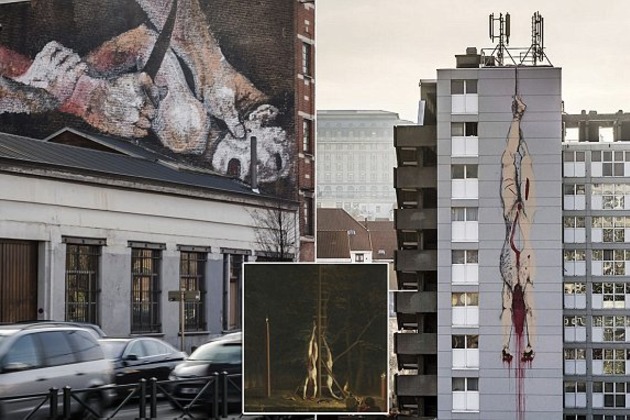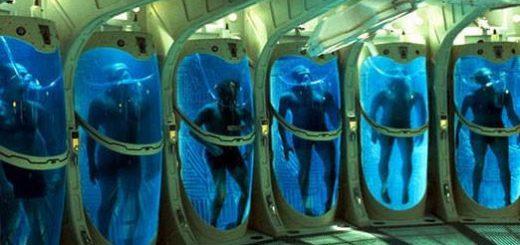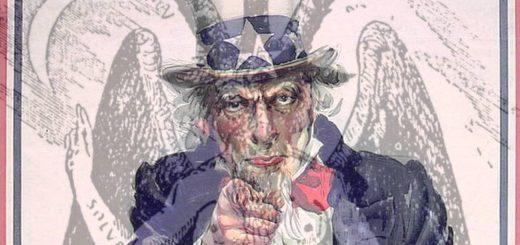This is the final part of our Marc Dutroux investigation.Paedophile Dutroux’s support system in law enforcement and legal circles came into their own as the case wound up. I think it’s important to place these facts out in the open once more for public evaluation because much information is buried in “conspiracy” sites.
In April 1996, Dutroux ended his four-month sentence for car theft and promptly carried on where he had left off. As we saw in part two, Operation Othello, the watching of his house, had been called off by police officer Rene Michaux.
This man had been down to the dungeon himself and heard the screams of the two then-alive girls. He had ignored and even hushed up the screams, according to the locksmith who accompanied him. Years later in court, Michaux claimed that he thought the cries were coming from outside, in the street!
The face of this sinister police officer bears that strange flicker of evil that paedophiles are prone to exhibit. He played a central role in keeping attention away from Dutroux when the latter started abducting girls. By calling off the watching of his house, he kept up his good work by clearing the way for Dutroux to continue.
Dutroux didn’t waste any time. Within a month of his release, he abducted 12-year-old Sabine Dardenne. Her disappearance was to remain a mystery to the police. Small wonder, as an outgoing magistrate hadn’t even bothered to inform her replacement of the ongoing missing girls’ cases.
In August 1996, 14-year-old Laetitia Delhez was abducted. Dutroux claimed later in court that it was for “company” for his other captive.
This time the community swung into action and the local police force became passionately involved in the search, a definite departure from the behaviour we’ve seen of their compatriots in other regions. The result was that information about a suspicious van came forward. A match was obtained to Dutroux through a partially remembered licence plate. He had finally been caught.
Dutroux led them to his dungeon early on a Monday morning. The 14-year-old who had been abducted six days earlier was found. The discovery of the other girl who had been there for two months was surprising to some.
As the girls were freed from the cage, they ran to hug and kiss Dutroux, who apparently enjoyed the moment. They had been brainwashed into thinking that Dutroux was protecting them from “bad people”. These were now the bad people that had arrived to come get them.
It is important to highlight the role of the investigative Judge, Jean-Marc Connerotte. He was apparently instrumental in securing the arrest of Dutroux and greatly admired by the public when it became clear he was practically a lone ranger surrounded by criminal incompetence.
In August, Connerotte appealed for other victims of paedophile rings to come forward with testimony.
Thirty-three-year-old Regina Louf responded. She described various orgies she had attended in her youth in detail and named a prominent Belgian businessman, Jean-Michel Nihoul, as the chief organiser. She had also seen a young Dutroux there. She described a house in detail and a murder she had seen at a “sex slave” party in 1984.
Dutroux alleged from the beginning that he was not acting alone, saying that Nihoul was the actual “brains” of the operation. The authorities were determined not to believe him.
Here’s how an Observer reporter, who did an excellent piece in 2002, described her meeting with Nihoul prior to his arrest: “During the course of our meal he, apparently playfully, grabbed me, tickling, and finally pulled me over on to him in the restaurant booth until I had to appeal to my colleagues for rescue.”
He had greeted her by saying he was the “monster of Belgium”.
A playful monster, in other words.
“He has all but dared the state to prosecute him,” said the BBC, “claiming that he is beyond the reach of the law because he has information that, if made public, ‘would bring the government and the entire state down’.”
In custody Nihoul confessed to “organising an orgy at a Belgium chateau, which several government officials, police officers and a former European commissioner attended”.
As victims started coming forward and confessing to sexual abuse in their youth and the same names kept popping up, the notion that Dutroux was acting alone was becoming less and less credible. The media were obviously in full swing by now, with the “House of horror” headlines we can all remember.
By mid-October, the citizens of Belgium were stirred to public outrage as details of the police mismanagement started appearing. “The Justice Ministry was sitting on a politically sensitive list of customers of paedophile videotapes,” said a report in the Los Angeles Times at the time. This list drifted into obscurity.
What tipped public outcry into mass protest was when “the investigative Judge in the Dutroux case, Jean-Marc Connerotte, was dismissed. Many Belgians viewed Connerotte as a hero because he secured the arrest of Marc Dutroux and collected significant evidence against him that would help convict Dutroux and those in his paedophile ring.
“Belgium’s Supreme Court removed Connerotte because he attended a fund-raising dinner, which was organised to help in the search for missing children. It was later decided that his attendance at the fund-raising event caused him to lose his objectivity when investigating the Dutroux case.”
The suspicious dismissal of Connerotte led to a remarkable march. Called the White March, it was the biggest public demonstration in Belgium since the Nüremberg trials. The public were given strong reassurances by the government of a shake-up of the police system and justice triumphing.
But this was not forthcoming. In fact, the opposite tendency was already gaining momentum, silently, away from public statements.
The removal of Connerotte complete, the network set to work at discrediting the testimony of Regina Louf. As mentioned, Louf had supplied details of a murder she had witnessed at a party attended by Dutroux and Nihoul.
Said the Observer: “Christine van Hees’s body had been found in 1984 dumped in the grounds of a disused mushroom farm on the outskirts of Brussels. The farm was later demolished, but in 1996 Louf described to the police team its intricate details, the wallpaper, the sinks, hooks on the ceiling, a network of stairs and adjoining rooms unique to that building.”
A man who grew up at the farm, the son of the former owner, showed the Observer reporter photographs of the house and the mushroom factory. “He said: ‘I have never met Regina Louf. All I know is that she could not have described the house as well as she did unless she’d been there. It was two houses joined together in a strange way. It would be impossible to invent it.’”
For 12 years the unsolved murder of Van Hees gathered dust in the Brussels files under the direction of Judge Van Espen. Two years ago, a Belgian journalist revealed the close relationship between Van Espen and Nihoul and his then wife.
As a lawyer, Van Espen had represented Nihoul’s wife. Van Espen’s sister was the godmother of Nihoul’s child. Yet, when Louf accused these two of the murder, Van Espen saw no conflict of interest and no reason to resign. Nor was he sacked, as Connerotte had been. Instead he was allowed to order the police officers to stay out of the case. Van Espen only resigned as the judge in charge of the mushroom-factory investigation in early 1998 after his relationship with Nihoul was exposed.
A strange co-incidence, isn’t it? No wonder it was so important to discredit Regina Louf, as she had evidence that not only connected Dutroux to Nihoul, but also Nihoul to very prominent judicial officials.
In its response, the network didn’t disappoint, coming out guns blazing.
Observer: “In the spring of 1997, Louf’s interrogators had been sent home without explanation and a new team was assigned to ‘reread’ her testimony. The press was briefed that the previous team had been removed because they had manipulated the evidence of Louf, who was then known by the code name X1. It is a charge which the police team has always vigorously denied and which has never been substantiated.”
But they weren’t finished yet.
“And then the media campaign began. Louf’s name was leaked to the press. The government-owned TV station RTBF began a campaign designed to prove that Dutroux was an ‘isolated pervert’ kidnapping girls for himself, that there was no network, that Nihoul was innocent and Louf was a liar.
“Belgium’s flagship current-affairs television programme, Au Nom de La Loi , floated Louf’s face over a backdrop of crows pecking over debris orchestrated by a Blair Witch-style soundtrack. Her ageing parents appeared as tragic victims of a deranged fantasist, whose false memories had blighted their last years.”
“What the programme makers knew but didn’t say was that the parents had already admitted to police that a family friend in his 40s, Tony van den Bogaert, had had a key to their home and unlimited access to their 12-year-old daughter. Nor did they tell their viewers that Van den Bogaert had himself admitted his relationship with Louf to police.
“Van den Bogaert lives freely on the borders of Belgium and Holland unmolested by the law or the press. Au Nom de La Loi has never attempted to track him down and expose this self-confessed paedophile. Instead it has devoted hours of airtime to destroying the name of his victim, Louf, whose only offence appears to be that she was prepared to testify about the organised abuse she’d suffered as a child.
“This campaign has succeeded. Judges have announced that Louf will not be called as a witness in any future trial of Dutroux or his associates. Her testimony and that of all the 10 witnesses who came forward to Judge Connerotte has been declared worthless.”
“Even the Prosecutor General of the Dutroux case, Anne Thily, seems to have been in on the shady action, saying that Louf was a ‘fantasist’ and had ‘invented everything’.
“Connerotte’s replacement, Judge Langlois, also parked his car in the same garage, because he blatantly refused permission for the hairs gathered in Dutroux’s dungeon to be sent for DNA analysis ‘despite pressure from his prosecutor, Michel Bourlet, who believed that a DNA identification of those hairs might reveal who else was involved’.”
His boss Thily backed him all the way.
“There was no need to get the hairs analysed as no one else entered the cage,” she said. “There was no network so there was no need to look for evidence of one.”
What ingenious rubbish. Bad scriptwriters wouldn’t even be able to come up with something like this.
“In any case,” she continued, “the hairs have all now been analysed — all 5 000.”
And the results of this analysis? asked the Observer reporter.
“Nothing.”
Thily flashed a “triumphant” smile at the reporter.
She concluded: “No evidence of any relevance in the Dutroux affair. Which proves, of course, that Langlois was right all along.”
The Observer reporter had done her homework.
“Sources central to the investigation confirm that to date the hairs have still not been analysed.”
The reporter caught Thily out again when she said that “the bodies were too decomposed to test for DNA”.
“The autopsy states clearly that the bodies were not decomposed,” said the reporter. “Samples were taken. But no one seems to know what has happened to the results.”
So yes, the picture by now had gotten much murkier, with a return to the former “incompetence” that had so tragically been manifested before. The Dutroux case had been hijacked yet again, this time by the chief prosecutor.
Behind the scenes, the murder of potential witnesses was occurring by now. Publicly the cause of death was all declared “suicide”. Things take a rather macabre turn when you hear that even Nihoul’s dentist committed “suicide”.
But back to the official side of the case. Here, under the dodgy auspices of Judge Langlois of “no DNA” fame, the investigation took on another pace altogether. The citizens of Belgium were basically being dealt a collective slap in the face as the trial stalled and crawled along — for another eight years.
Here’s the excuse for the delay.
The Observer: “The official explanation for the delay is that hysterical conspiracy theories forced investigators to search for paedophile networks which didn’t exist.”
Oh, there we go again. Dutroux acted alone.
“But far from being investigated, leads pointing to a network seem rather to have been ignored or buried.”
Even though Dutroux “acted alone”, he still apparently had some friends willing to lend a hand, because in 1997 the prison “allowed Dutroux to leave the building to consult files that would be used in his upcoming trial”. Dutroux used the opportunity and “overpowered a police officer that was guarding him, and escaped for three hours”.
As late as March 18 2004, “a handcuff key was found in Dutroux’s cell, apparently smuggled in a salt bag. Prison authorities were accused to trying to arrange Dutroux’s escape.”
The year 2004 finally saw the sentencing of Dutroux. He obviously — or under the circumstances, perhaps one should say surprisingly — got a life sentence.
His ex-wife Michelle Martin, the woman who stopped feeding the youngsters in the dungeon because she was “afraid of them”, got 30 years. Accomplice businessman Michel Lelievre got 25 years.
The monster of Belgium, Nihoul, got a mere five years. He must have been thrilled. That means, by the end of the year, he’ll be back among us.
The aftermath of this whole affair leaves one with a troubling picture of how dark deeds can flourish in very influential circles. It’s surely little comfort to the bereaved families to know that the full picture of this monstrous episode may never fully emerge.
If indeed Dutroux was part of a much bigger network, as seems likely when one looks at the evidence, then most of its members escaped detection. It seems bizarre to think that such a network can exist and include politicians and other highly placed members of society. It takes quite some machinery to deflect the outraged attention of an entire country. But they managed it.
By 2002, the citizens who had taken part in the march were no longer being hailed but called a “mob” in certain newspapers. The rehabilitation had been exhaustively applied.
Dutroux acted alone! That’s the official version that wants to house itself in our collective memory.
The journalists who pierced the fabric of this complicated cover-up and exposed the dishonesty reeling in its wake have done their community a great service. We can be lucky that we live in a time when it is more difficult to conceal facts than a few decades ago. And yet so much remains unanswered, buried in the pile of yesterday’s papers. The general public don’t hold their interest for long, as we’re seeing with the Madeleine McCann saga.
It’s bitter to discover that Rene Michaux, the police officer who took that fateful trip down the stairs to the dungeon and heard the screams, was never even charged. He’s almost 60 now and is probably hoping to take his secrets to his grave.
The others who were involved appear, for the time being, to have gotten away with it. Many of them may even be flourishing in state and judicial circles all over Europe, which might explain why the McCann investigation has been such a tragic mess.


 Headless Corpse
Headless Corpse













